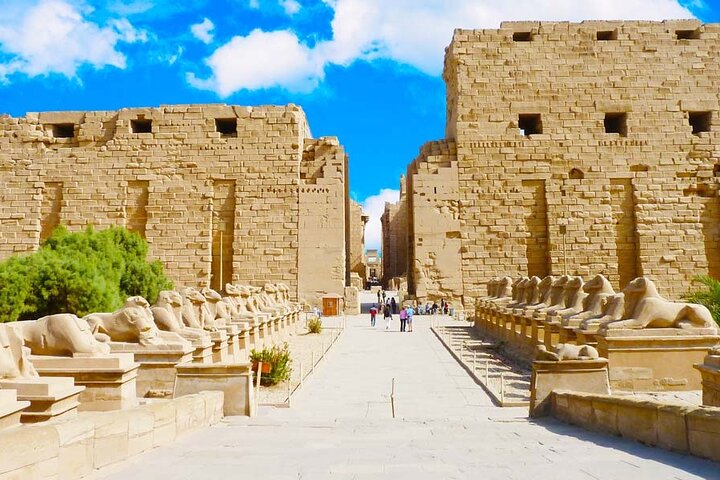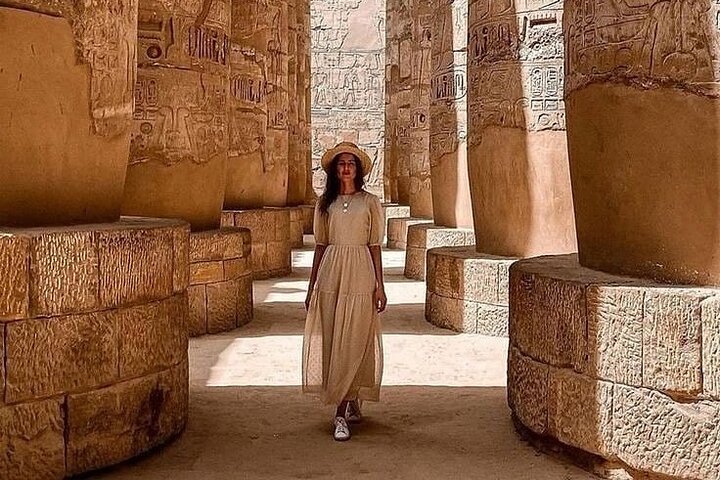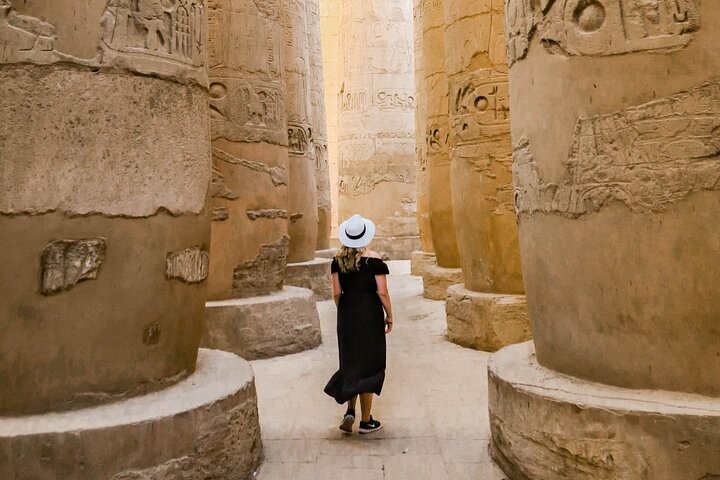Best of Luxor in 3 Days from Luxor ( All Of Luxor ) Hot Air Balloon ( Optional )
Share this tour

Offered languages
- German
- German
- German
- English
- English
- English
- Italian
- Italian
- Italian
- French
- French
- French
- Spanish
- Spanish
- Spanish
Private 3 days tour to see the best ancient monuments of the East and West Bank in Luxor. These monuments include Valley of the Kings (Necropolis of Thebes), Valley of the Queens, Temple of Hatshepsut (Deir el Bahari), Ramesseum (Mortuary Temple of Ramses II), Valley of the Artisans (Deir el Medina), the Temple of Medinat Habu (Temple of Ramses III), Tombs of the Nobles (Valley of the Nobles), the Colossi of Memnon, Luxor Museum, Karnak and Luxor Temples.
What's Included
Lunch
Breakfast
Meeting and pickup
we pick up all travelers from any hotel and airport in Luxor
Itinerary
-
1Valley of the Kings
The Valley of the Kings, also known as "The Valley of the Kings", is a valley in Egypt that was used for 500 years during the period between the sixteenth and eleventh centuries BC to construct tombs for the pharaohs and nobles of the modern state extending during the eighteenth dynasties to the twentieth dynasty in ancient Egypt. The valley on the west bank of the Nile River facing Thebes (Luxor now) in the heart of the ancient funerary city of Thebes. The Valley of the Kings is divided into two valleys; The Eastern Valley (where most of the royal tombs are located) and the Western Valley. And with the discovery of the last burial chamber in 2006, known as (Cemetery 63), in addition to the discovery of two other entrances to the same chamber during 2008.
2 hours • Admission ticket not included -
2Temple of Hatshepsut at Deir el Bahari
The Temple of Hatshepsut or the mortuary temple of Hatshepsut is a temple from the Eighteenth Dynasty of Egypt, and the best remaining temples were built about 3500 years ago in Deir el-Bahari, Egypt. It was built by Queen Hatshepsut on the west bank of the Nile opposite to Thebes (the capital of ancient Egypt and the seat of the Amun worship) (Luxor today). The Temple of Hatshepsut is distinguished by its unique architectural design, in comparison to the Egyptian temples that were built on the eastern bank of the Nile at Thebes. The temple consists of three successive floors with open terraces. The temple was built of limestone, and in front of the second floor columns were erected limestone statues of the god Osiris and Queen Hatshepsut in a beautiful distribution. Originally, those statues were colored, and now only some monuments remain of the colors, and some statues are in very good condition, indicating the elegance and beauty of the temple's design.
1 hour • Admission ticket not included -
3Colossi of Memnon
Colossus of Memnon, known locally as (Al-Kulsat or Salamat), is two huge statues, built around the year 1350 BC, which are all that remains of a temple built in memory of Pharaoh Amenhotep III, who ruled Egypt during the eighteenth dynasty, located in the funeral city of Thebes Located west of the Nile in the present-day city of Luxor, the two identical statues depict Amenhotep III (14th century BC) seated, hands spread on his knees and looking eastward (in fact toward the southeast in modern directions) toward the river. Two short figures are carved on the front of the throne, along with his legs: his wife Tiye and his mother Death M and Ya. The side panels depict the Nile god Habi. The statues were made from blocks of quartzite sandstone that were quarried from Jabal al-Ahmar (near present-day Cairo) and transported 675 km (420 mi) overland to Thebes (Luxor).
30 minutes • Admission ticket included -
4Temple of Karnak
Karnak, or the Karnak Temple Complex, which is known as the Karnak Temple, is a group of temples, buildings and columns, where the expansion and construction processes continued since the Pharaonic era, specifically the kings of the Middle Kingdom, until the Roman era in Luxor in Egypt on the eastern coast. The temple was built for the divine triad Amun (Amun Ra in the modern era), his wife the goddess Mut and their son the god Khonsu; And each of them has a temple belonging to the Karnak Temples Complex. The temple was named with this name in relation to the city of Karnak, and it is a modern name that is distorted from the Arabic word Khurang, meaning the fortified village, which was given to many temples in the area during this period. While the temple was known in the beginning as "Bar Amun", meaning the temple of Amun or Betamun, and during the Middle Kingdom it was called the name Ibt Sut, which means the most chosen of places (sometimes translated as the chosen spot)
2 hours • Admission ticket not included -
5
There you can admire the Hypostyle Hall, Obelisks of Queen Hatshepsut and Tutomosis I, the Temple of Amon, the Granite Scarbeus of Amenophis III and the Sacred Lake.
45 minutes • Admission ticket not included -
6Luxor Museum
ou will be brought to the Luxor Museum, which houses items found in Tutankhamun's tomb.
1 hour • Admission ticket not included -
7Luxor Temple
The next stop will be at Luxor Temple, which is dedicated to the Theben Triad of Amun-Ra, Mut, and Khonsu. There you will see statues of Ramses the Great and the Avenue of Sphinxes. After touring the sites you will be transferred back to your hotel.
1 hour • Admission ticket not included -
8Valley of the Artisans (Deir el-Medina)
After breakfast your Egyptologist tour guide and driver will pick you up to enjoy another guided tour of the West Bank of Luxor. There you visit Valley of the Artisans (Deir el Medina), Ramesseum (Mortuary Temple of Ramses II),
30 minutes • Admission ticket not included -
9Valley of the Nobles
Tombs of the Nobles (Valley of the Nobles) and Valley of the Queens. After touring the sites you will be transported back to your accommodation.
45 minutes • Admission ticket not included
Luxor - Valley of the Kings,Temple of Queen Hatshepsut,Colossi of Memnon
Luxor- Karnak Temples,Hypostyle Hall,Obelisks of Queen Hatshepsut and Tutomosis I, Luxor Museum,Luxor Temple
Luxor- Deir el Medina, Ramesseum,Mortuary Temple of Ramses II,Tombs of the Nobles,Valley of the Nobles,and Valley Queens
Additional info
- Wheelchair accessible
- Infants and small children can ride in a pram or stroller
- Public transportation options are available nearby
- Specialized infant seats are available
- Transportation options are wheelchair accessible
- All areas and surfaces are wheelchair accessible
Show 1 more
Additional info
- Wheelchair accessible
- Infants and small children can ride in a pram or stroller
- Public transportation options are available nearby
- Specialized infant seats are available
- Transportation options are wheelchair accessible
- All areas and surfaces are wheelchair accessible
- Suitable for all physical fitness levels
Tags
Cancellation Policy
For a full refund, cancel at least 24 hours before the scheduled departure time.
Show more
Cancellation Policy
- For a full refund, you must cancel at least 24 hours before the experience’s start time.
- If you cancel less than 24 hours before the experience’s start time, the amount you paid will not be refunded.
- Any changes made less than 24 hours before the experience’s start time will not be accepted.
- This experience requires a minimum number of travelers. If it’s canceled because the minimum isn’t met, you’ll be offered a different date/experience or a full refund.
You can cancel up to 24 hours in advance of the experience for a full refund.
Your guide to the flawless travel experience















